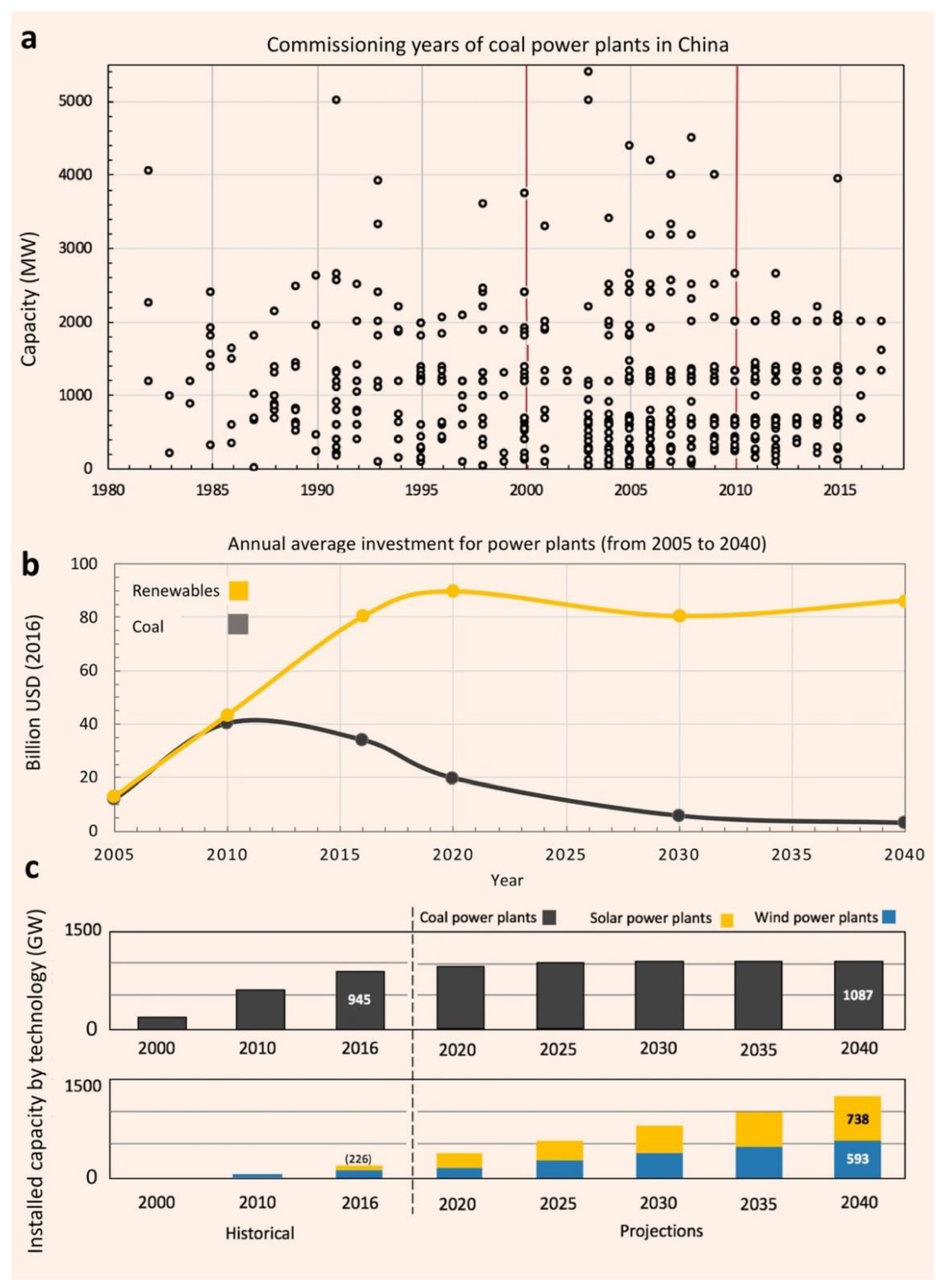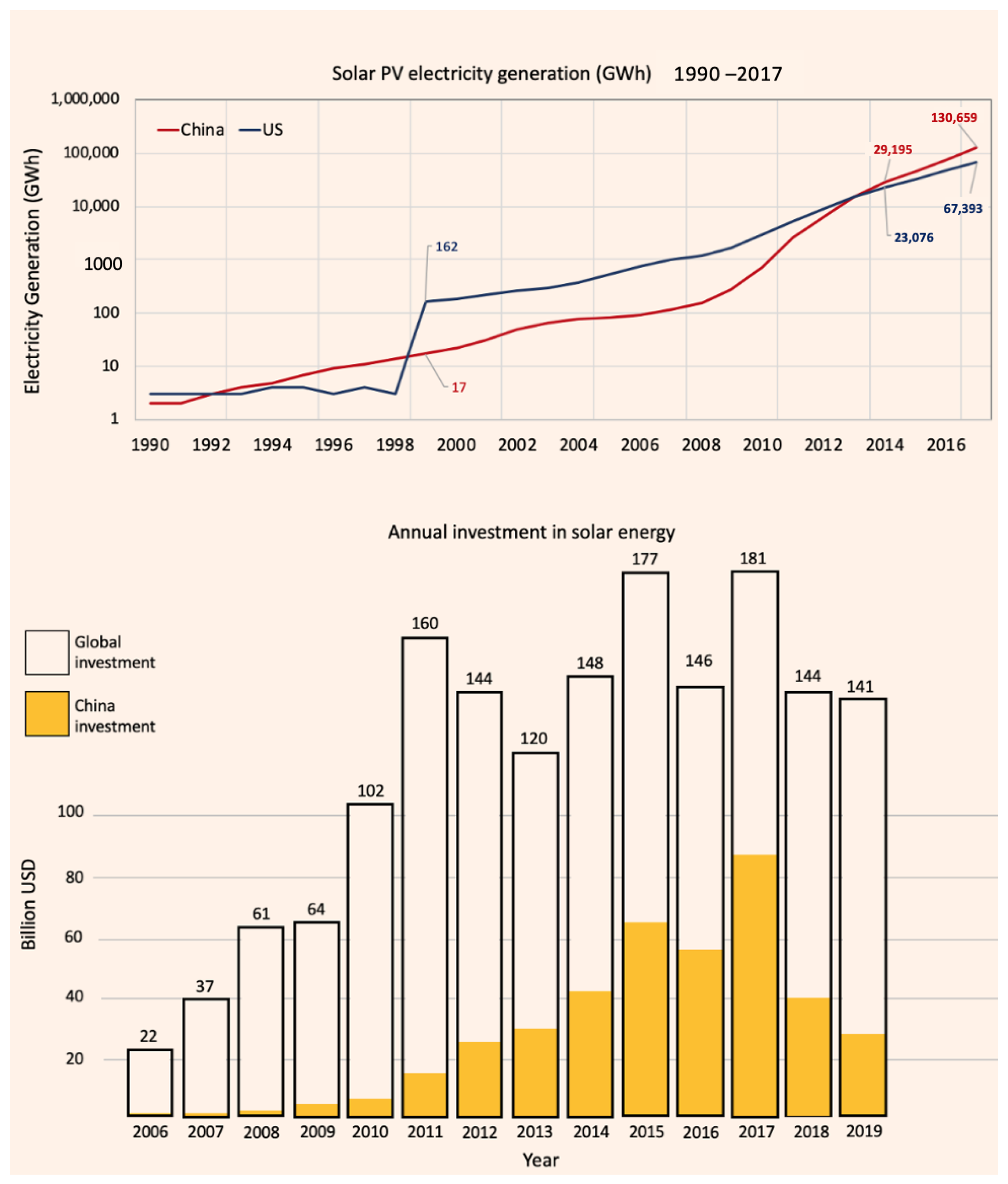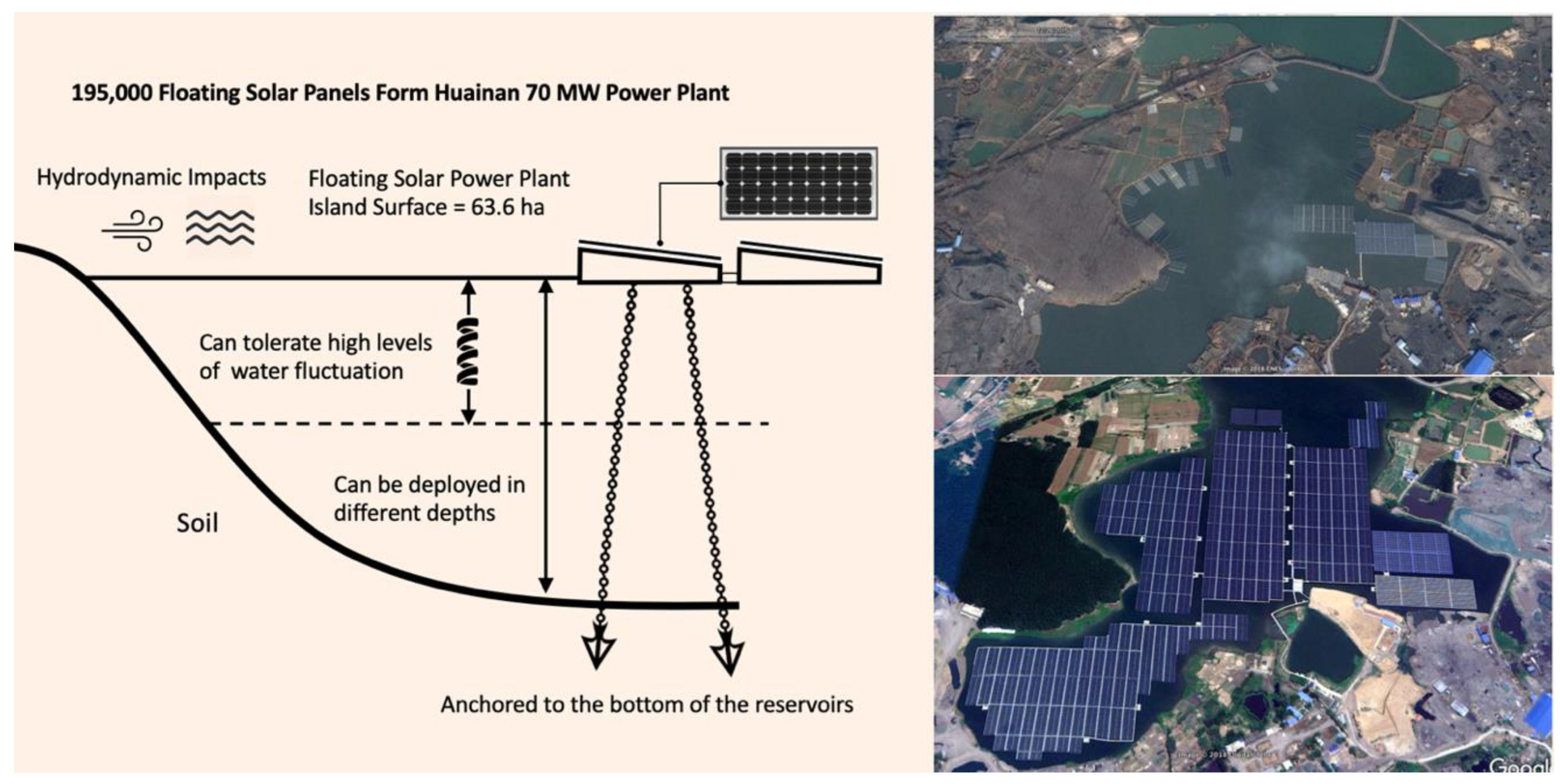What China’s Environmental Policy Means for PV Solar, Electric Vehicles, and Carbon Capture and Storage Technologies
Abstract
1. Introduction
2. Adopting a Clean Energy Mix to Address Environmental Pollution
3. China’s New Environmental Policies Influence PV Solar, Electric Vehicles, and CCS Technologies
3.1. Photovoltaic (PV) Solar Energy
3.2. Sustainable Transport and Electric Vehicles
3.3. Carbon Capture and Storage (CCS)
4. Conclusions
Author Contributions
Funding
Conflicts of Interest
References
- Pouran, H.M. From Collapsed Coal Mines to Floating Solar Farms, Why China’s New Power Stations Matter. Energy Policy 2018, 123, 414–420. [Google Scholar] [CrossRef]
- Chen, W.; Zheng, R.; Baade, P.D.; Zhang, S.; Zeng, H.; Bray, F.; Jemal, A.; Yu, X.Q.; He, J. Cancer Statistics in China, 2015. CA Cancer J. Clin. 2016, 66, 115–132. [Google Scholar] [CrossRef] [PubMed]
- Rai, P.K.; Lee, S.S.; Zhang, M.; Tsang, Y.F.; Kim, K.H. Heavy Metals in Food Crops: Health Risks, Fate, Mechanisms, and Management. Environ. Int. 2019, 125, 365–385. [Google Scholar] [CrossRef] [PubMed]
- Guo, Y.; Zeng, H.; Zheng, R.; Li, S.; Barnett, A.G.; Zhang, S.; Zou, X.; Huxley, R.; Chen, W.; Williams, G. The Association between Lung Cancer Incidence and Ambient Air Pollution in China: A Spatiotemporal Analysis. Environ. Res. 2016, 144, 60–65. [Google Scholar] [CrossRef] [PubMed]
- World Health Organization. Air Pollution in China. Available online: https://www.who.int/china/health-topics/air-pollution (accessed on 14 November 2022).
- Labordena, M.; Neubauer, D.; Folini, D.; Patt, A.; Lilliestam, J. Blue skies over China: The effect of pollution-control on solar power generation and revenues. PLoS ONE 2018, 13, e0207028. [Google Scholar] [CrossRef]
- Wike, R.; Stokes, B.; Stewart, R. Chinese Public Sees More Powerful Role in World, Names U.S. as Top Threat Domestic Challenges Persist: Corruption, Consumer Safety, Pollution; Pew Research Center: Washington, DC, USA, 2016. [Google Scholar]
- Pew Research Center. Air Pollution a Major Concern in China. Available online: http://www.pewresearch.org/fact-tank/2015/12/10/as-smog-hangs-over-beijing-chinese-cite-air-pollution-as-major-concern/ (accessed on 13 November 2018).
- Wong, M.-H. Chemical Pollution and Seafood Safety, with a Focus on Mercury: The Case of Pearl River Delta, South China. Environ. Technol. Innov. 2017, 7, 63–76. [Google Scholar] [CrossRef][Green Version]
- Han, D.; Currell, M.J.; Cao, G. Deep Challenges for China’s War on Water Pollution. Environ. Pollut. 2016, 218, 1222–1233. [Google Scholar] [CrossRef]
- Zeng, Y.; Cao, Y.; Qiao, X.; Seyler, B.C.; Tang, Y. Air Pollution Reduction in China: Recent Success but Great Challenge for the Future. Sci. Total Environ. 2019, 663, 329–337. [Google Scholar] [CrossRef]
- Wang, T.; Xue, L.; Brimblecombe, P.; Lam, Y.F.; Li, L.; Zhang, L. Ozone Pollution in China: A Review of Concentrations, Meteorological Influences, Chemical Precursors, and Effects. Sci. Total Environ. 2017, 575, 1582–1596. [Google Scholar] [CrossRef]
- Feng, Z.; De Marco, A.; Anav, A.; Gualtieri, M.; Sicard, P.; Tian, H.; Fornasier, F.; Tao, F.; Guo, A.; Paoletti, E. Economic Losses Due to Ozone Impacts on Human Health, Forest Productivity and Crop Yield across China. Environ. Int. 2019, 131, 104966. [Google Scholar] [CrossRef]
- Maji, K.J.; Dikshit, A.K.; Arora, M.; Deshpande, A. Estimating Premature Mortality Attributable to PM2.5 Exposure and Benefit of Air Pollution Control Policies in China for 2020. Sci. Total Environ. 2018, 612, 683–693. [Google Scholar] [CrossRef] [PubMed]
- Yao, M.; Wu, G.; Zhao, X.; Zhang, J. Estimating Health Burden and Economic Loss Attributable to Short-Term Exposure to Multiple Air Pollutants in China. Environ. Res. 2020, 183, 109184. [Google Scholar] [CrossRef] [PubMed]
- Maji, K.J.; Ye, W.-F.; Arora, M.; Nagendra, S.S. PM2.5-Related Health and Economic Loss Assessment for 338 Chinese Cities. Environ. Int. 2018, 121, 392–403. [Google Scholar] [CrossRef] [PubMed]
- Barwick, P.J.; Li, S.; Rao, D.; Zahur, N. Bin the Morbidity Cost of Air Pollution: Evidence from Consumer Spending in China; SSRN: Rochester, NY, USA, 2018. [Google Scholar]
- Xiang, J.; Seto, E.; Mo, J.; Zhang, J.; Zhang, Y. Impacts of Implementing Healthy Building Guidelines for Daily PM2.5 Limit on Premature Deaths and Economic Losses in Urban China: A Population-Based Modeling Study. Environ. Int. 2021, 147, 106342. [Google Scholar] [CrossRef] [PubMed]
- Zhang, G.; Gao, Y.; Li, J.; Su, B.; Chen, Z.; Lin, W. China’s Environmental Policy Intensity for 1978–2019. Sci. Data 2022, 9, 75. [Google Scholar] [CrossRef]
- Finkelman, R.B.; Tian, L. The Health Impacts of Coal Use in China. Int. Geol. Rev. 2018, 60, 579–589. [Google Scholar] [CrossRef]
- Karimi, S.M.; Maziyaki, A.; Moghadam, S.A.; Jafarkhani, M.; Zarei, H.; Moradi-Lakeh, M.; Pouran, H. Continuous Exposure to Ambient Air Pollution and Chronic Diseases: Prevalence, Burden, and Economic Costs. Rev. Environ. Health 2020, 35, 379–399. [Google Scholar] [CrossRef]
- Anasis, J.G.; Khalil, M.A.K.; Butenhoff, C.; Bluffstone, R.; Lendaris, G.G. Optimal Energy Resource Mix for the US and China to Meet Emissions Pledges. Appl. Energy 2019, 238, 92–100. [Google Scholar] [CrossRef]
- Chen, J.; Li, Z.; Song, M.; Wang, Y.; Wu, Y.; Li, K. Economic and Intensity Effects of Coal Consumption in China. J. Environ. Manag. 2022, 301, 113912. [Google Scholar] [CrossRef]
- Global Energy Observatory. KTH Royal Institute of Technology in Stockholm, Enipedia, World Resources Institute. 2019. Available online: http://resourcewatch.org (accessed on 27 November 2022).
- Yuan, J.; Na, C.; Lei, Q.; Xiong, M.; Guo, J.; Hu, Z. Coal Use for Power Generation in China. Resour. Conserv. Recycl. 2018, 129, 443–453. [Google Scholar] [CrossRef]
- Qiao, H.; Chen, S.; Dong, X.; Dong, K. Has China’s Coal Consumption Actually Reached Its Peak? National and Regional Analysis Considering Cross-Sectional Dependence and Heterogeneity. Energy Econ. 2019, 84, 104509. [Google Scholar] [CrossRef]
- China and Coronavirus|Financial Times. Available online: https://www.ft.com/content/821cd8c8-436d-11ea-abea-0c7a29cd66fe (accessed on 24 February 2020).
- Shi, X.; Rioux, B.; Galkin, P. Unintended Consequences of China’s Coal Capacity Cut Policy. Energy Policy 2018, 113, 478–486. [Google Scholar] [CrossRef]
- Airborne Nitrogen Dioxide Plummets over China. Available online: https://earthobservatory.nasa.gov/images/146362/airborne-nitrogen-dioxide-plummets-over-china (accessed on 1 March 2020).
- Wang, J.; Qiu, Y.; He, S.; Liu, N.; Xiao, C.; Liu, L. Investigating the Driving Forces of NOx Generation from Energy Consumption in China. J. Clean. Prod. 2018, 184, 836–846. [Google Scholar] [CrossRef]
- Agency, I.E. World Energy Outlook 2017: China—Analysis—IEA. Available online: https://www.iea.org/reports/world-energy-outlook-2017-china (accessed on 24 February 2020).
- Renewable Energy Agency China—Countries & Regions—IEA. Available online: https://www.iea.org/countries/china (accessed on 24 February 2020).
- Chen, J.; Xu, C.; Gao, M.; Li, D. Carbon Peak and Its Mitigation Implications for China in the Post-Pandemic Era. Sci. Rep. 2022, 12, 3473. [Google Scholar] [CrossRef]
- Haegel, N.M.; Margolis, R.; Buonassisi, T.; Feldman, D.; Froitzheim, A.; Garabedian, R.; Green, M.; Glunz, S.; Henning, H.M.; Holder, B.; et al. Terawatt-Scale Photovoltaics: Trajectories and Challenges. Science 2017, 356, 141–143. [Google Scholar] [CrossRef]
- Zhang, D.; Wang, J.; Lin, Y.; Si, Y.; Huang, C.; Yang, J.; Huang, B.; Li, W. Present Situation and Future Prospect of Renewable Energy in China. Renew. Sustain. Energy Rev. 2017, 76, 865–871. [Google Scholar] [CrossRef]
- Di Silvestre, M.L.; Favuzza, S.; Sanseverino, E.R.; Zizzo, G. How Decarbonization, Digitalization and Decentralization Are Changing Key Power Infrastructures. Renew. Sustain. Energy Rev. 2018, 93, 483–498. [Google Scholar] [CrossRef]
- International Energy Agency Statistics|World—Total Primary Energy Supply (TPES) by Source (Chart). Available online: https://www.iea.org/statistics/?country=WORLD&year=2016&category=Keyindicators&indicator=TPESbySource&mode=chart&categoryBrowse=false&dataTable=BALANCES&showDataTable=false (accessed on 13 November 2018).
- IEA. Data & Statistics—IEA. Available online: https://www.iea.org/data-and-statistics?country=CHINAREG&fuel=Energysupply&indicator=Electricitygenerationbysource (accessed on 24 February 2020).
- Feldman, D.; Hoskins, N.J.; Margolis, D.R. Q4 2017/Q1 2018 Solar Industry Update; National Renewable Energy Lab (NREL): Golden, CO, USA, 2017.
- Clean Energy Investment 2019|Bloomberg NEF. Available online: https://data.bloomberglp.com/professional/sites/24/BloombergNEF-Clean-Energy-Investment-Trends-2019.pdf (accessed on 26 February 2020).
- Xin-Gang, Z.; Zhen, W. Technology, Cost, Economic Performance of Distributed Photovoltaic Industry in China. Renew. Sustain. Energy Rev. 2019, 110, 53–64. [Google Scholar] [CrossRef]
- Kavlak, G. Drivers of Photovoltaics Cost Evolution. Ph.D. Thesis, Massachusetts Institute of Technology, Cambridge, MA, USA, 2018. [Google Scholar]
- Zhang, F.; Gallagher, K.S. Innovation and Technology Transfer through Global Value Chains: Evidence from China’s PV Industry. Energy Policy 2016, 94, 191–203. [Google Scholar] [CrossRef]
- Buckley, T.; Nicholas, S.; Brown, M. China 2017 Review, World’s Second-Biggest Economy Continues to Drive Global Trends in Energy Investment; Institute for Energy Economics and Financial Analysis: Cleveland, OH, USA, 2018. [Google Scholar]
- Spencer, R.S.; Macknick, J.; Aznar, A.; Warren, A.; Reese, M.O. Floating Photovoltaic Systems: Assessing the Technical Potential of Photovoltaic Systems on Man-Made Water Bodies in the Continental United States. Environ. Sci. Technol. 2019, 53, 1680–1689. [Google Scholar] [CrossRef]
- Li, X.; Wagner, F.; Peng, W.; Yang, J.; Mauzerall, D.L. Reduction of Solar Photovoltaic Resources Due to Air Pollution in China. Proc. Natl. Acad. Sci. USA 2017, 114, 11867–11872. [Google Scholar] [CrossRef]
- Güneralp, B.; Zhou, Y.; Ürge-Vorsatz, D.; Gupta, M.; Yu, S.; Patel, P.L.; Fragkias, M.; Li, X.; Seto, K.C. Global Scenarios of Urban Density and Its Impacts on Building Energy Use through 2050. Proc. Natl. Acad. Sci. USA 2017, 114, 8945–8950. [Google Scholar] [CrossRef]
- Chua, R.Y.J.; Huang, K.G.; Jin, M. Mapping Cultural Tightness and Its Links to Innovation, Urbanization, and Happiness across 31 Provinces in China. Proc. Natl. Acad. Sci. USA 2019, 116, 6720–6725. [Google Scholar] [CrossRef]
- Li, G.; Sun, S.; Fang, C. The Varying Driving Forces of Urban Expansion in China: Insights from a Spatial-Temporal Analysis. Landsc. Urban Plan. 2018, 174, 63–77. [Google Scholar] [CrossRef]
- The World Bank. Urban Population (% of Total Population)—China|Data. Available online: https://data.worldbank.org/indicator/SP.URB.TOTL.IN.ZS?locations=CN (accessed on 26 February 2020).
- Guan, X.; Wei, H.; Lu, S.; Dai, Q.; Su, H. Assessment on the Urbanization Strategy in China: Achievements, Challenges and Reflections. Habitat Int. 2018, 71, 97–109. [Google Scholar] [CrossRef]
- Wang, X.-R.; Hui, E.C.-M.; Choguill, C.; Jia, S.-H. The New Urbanization Policy in China: Which Way Forward? Habitat Int. 2015, 47, 279–284. [Google Scholar] [CrossRef]
- You, H.; Yang, X. Urban Expansion in 30 Megacities of China: Categorizing the Driving Force Profiles to Inform the Urbanization Policy. Land Use Policy 2017, 68, 531–551. [Google Scholar] [CrossRef]
- International Energy Agency. Global EV Outlook 2019 Scaling up the Transition to Electric Mobility; IEA: Paris, France, 2019; Available online: https://www.iea.org/reports/global-ev-outlook-2019 (accessed on 27 November 2022).
- Reality Check. Nat. Energy 2018, 3, 245. [CrossRef]
- Zhang, X.; Liang, Y.; Yu, E.; Rao, R.; Xie, J. Review of Electric Vehicle Policies in China: Content Summary and Effect Analysis. Renew. Sustain. Energy Rev. 2017, 70, 698–714. [Google Scholar] [CrossRef]
- Chen, X.; Zhang, H.; Xu, Z.; Nielsen, C.P.; McElroy, M.B.; Lv, J. Impacts of Fleet Types and Charging Modes for Electric Vehicles on Emissions under Different Penetrations of Wind Power. Nat. Energy 2018, 3, 413–421. [Google Scholar] [CrossRef]
- Chen, X.; Mcelroy, M.B.; Wu, Q.; Shu, Y.; Xue, Y. Transition towards Higher Penetration of Renewables: An Overview of Interlinked Technical, Environmental and Socio-Economic Challenges. J. Mod. Power Syst. Clean Energy 2019, 7, 1–8. [Google Scholar] [CrossRef]
- Global EV Outlook 2022—Data Product—IEA. Available online: https://www.iea.org/data-and-statistics/data-product/global-ev-outlook-2022 (accessed on 19 August 2022).
- Horn, M.; MacLeod, J.; Liu, M.; Webb, J.; Motta, N. Supercapacitors: A New Source of Power for Electric Cars? Econ. Anal. Policy 2019, 61, 93–103. [Google Scholar] [CrossRef]
- Pouran, H.M. Engineered Nanomaterials in the Environment, Their Potential Fate and Behaviour and Emerging Techniques to Measure Them. In Handbook of Environmental Materials Management; Springer International Publishing: Cham, Switzerland, 2019; pp. 1–15. [Google Scholar]
- Pouran, H.; Colodrero, R.P.; Wu, S.; Hix, G.; Zakharova, J.; Zhang, H. Assessment of ATR-FTIR Spectroscopy with Multivariate Analysis to Investigate the Binding Mechanisms of Ag and TiO2 Nanoparticles to Chelex®-100 or MetsorbTM for the DGT Technique. Anal. Methods 2020, 12, 959–969. [Google Scholar] [CrossRef]
- Mai, L.; Yan, M.; Zhao, Y. Track Batteries Degrading in Real Time. Nature 2017, 546, 469–470. [Google Scholar] [CrossRef]
- Berckmans, G.; Messagie, M.; Smekens, J.; Omar, N.; Vanhaverbeke, L.; Mierlo, J. Van Cost Projection of State of the Art Lithium-Ion Batteries for Electric Vehicles Up to 2030. Energies 2017, 10, 1314. [Google Scholar] [CrossRef]
- Yan, W.; Cao, H.; Zhang, Y.; Ning, P.; Song, Q.; Yang, J.; Sun, Z. Rethinking Chinese Supply Resilience of Critical Metals in Lithium-Ion Batteries. J. Clean. Prod. 2020, 256, 120719. [Google Scholar] [CrossRef]
- Seck, G.S.; Hache, E.; Barnet, C. Potential Bottleneck in the Energy Transition: The Case of Cobalt in an Accelerating Electro-Mobility World. Resour. Policy 2022, 75, 102516. [Google Scholar] [CrossRef]
- Sovacool, B.K. The Precarious Political Economy of Cobalt: Balancing Prosperity, Poverty, and Brutality in Artisanal and Industrial Mining in the Democratic Republic of the Congo. Extr. Ind. Soc. 2019, 6, 915–939. [Google Scholar] [CrossRef]
- Nkulu, C.B.L.; Casas, L.; Haufroid, V.; De Putter, T.; Saenen, N.D.; Kayembe-Kitenge, T.; Musa Obadia, P.; Mukoma, D.K.W.; Ilunga, J.M.L.; Nawrot, T.S.; et al. Sustainability of Artisanal Mining of Cobalt in DR Congo. Nat. Sustain. 2018, 1, 495–504. [Google Scholar] [CrossRef]
- Sun, X.; Hao, H.; Liu, Z.; Zhao, F.; Song, J. Tracing Global Cobalt Flow: 1995–2015. Resour. Conserv. Recycl. 2019, 149, 45–55. [Google Scholar] [CrossRef]
- Du, J.; Ouyang, M.; Chen, J. Prospects for Chinese Electric Vehicle Technologies in 2016–2020: Ambition and Rationality. Energy 2017, 120, 584–596. [Google Scholar] [CrossRef]
- Jian, L.; Zechun, H.; Banister, D.; Yongqiang, Z.; Zhongying, W. The Future of Energy Storage Shaped by Electric Vehicles: A Perspective from China. Energy 2018, 154, 249–257. [Google Scholar] [CrossRef]
- Sowinski, J. Application of Real Options Approach to Analyse Economic Efficiency of Power Plant with CCS Installation under Uncertainty. Energies 2022, 15, 1050. [Google Scholar] [CrossRef]
- Rahman, F.A.; Aziz, M.M.A.; Saidur, R.; Bakar, W.A.W.A.; Hainin, M.R.; Putrajaya, R.; Hassan, N.A. Pollution to Solution: Capture and Sequestration of Carbon Dioxide (CO2) and Its Utilization as a Renewable Energy Source for a Sustainable Future. Renew. Sustain. Energy Rev. 2017, 71, 112–126. [Google Scholar] [CrossRef]
- Bui, M.; Adjiman, C.S.; Bardow, A.; Anthony, E.J.; Boston, A.; Brown, S.; Fennell, P.S.; Fuss, S.; Galindo, A.; Hackett, L.A.; et al. Carbon Capture and Storage (CCS): The Way Forward. Energy Environ. Sci. 2018, 11, 1062–1176. [Google Scholar] [CrossRef]
- The CCS Institute New Wave of CCS Activity: Ten Large-Scale Projects Announced—Global CCS Institute. Available online: https://www.globalccsinstitute.com/news-media/press-room/media-releases/new-wave-of-ccs-activity-ten-large-scale-projects-announced/ (accessed on 3 March 2020).
- Zapantis, A.L.; Consoli, C.H.; Havercroft, I. Ccs Policy Indicator (CCS-PI); Global CCS Institute: Docklands, Australia, 2018. [Google Scholar]
- International Energy Agency. Energy Technology Perspectives 2017 Catalysing Energy Technology Transformations Together Secure Sustainable; IEA: Paris, France, 2017. [Google Scholar]
- International Energy Agency Energy Technology Perspective 2020. 2020. Available online: https://www.iea.org/reports/energy-technology-perspectives-2020 (accessed on 27 November 2022).
- Reiner, D.M. Learning through a Portfolio of Carbon Capture and Storage Demonstration Projects. Nat. Energy 2016, 1, 15011. [Google Scholar] [CrossRef]
- Borrero-Santiago, A.R.; Ribicic, D.; Bonnail, E.; Netzer, R.; Koseto, D.; Ardelan, M.V. Response of Bacterial Communities in Barents Sea Sediments in Case of a Potential CO2 Leakage from Carbon Reservoirs. Mar. Environ. Res. 2020, 160, 105050. [Google Scholar] [CrossRef]
- Raganati, F.; Ammendola, P.; Otto, D.; Pfeiffer, M.; De Brito, M.M.; Gross, M. Fixed Amidst Change: 20 Years of Media Coverage on Carbon Capture and Storage in Germany. Sustainability 2022, 14, 7342. [Google Scholar] [CrossRef]
- Pouran, H.M.; Banwart, S.A.; Romero-Gonzalez, M. Characterizing the Cell Surface Properties of Hydrocarbon-Degrading Bacterial Strains, a Case Study. In Handbook of Environmental Materials Management; Springer International Publishing: Cham, Switzerland, 2018; pp. 1–28. [Google Scholar]
- Pouran, H.M. Bacterial Cell-Mineral Interface, Its Impacts on Biofilm Formation and Bioremediation. In Handbook of Environmental Materials Management; Springer International Publishing: Cham, Switzerland, 2018; pp. 1–22. [Google Scholar]
- Van de Graaf, T.; Sovacool, B.K.; Ghosh, A.; Kern, F.; Klare, M.T. The Palgrave Handbook of the International Political Economy of Energy; Palgrave Macmillan: London, UK, 2016; ISBN 1137556315. [Google Scholar]
- Li, H.; Jiang, H.D.; Yang, B.; Liao, H. An Analysis of Research Hotspots and Modeling Techniques on Carbon Capture and Storage. Sci. Total Environ. 2019, 687, 687–701. [Google Scholar] [CrossRef]
- Rubin, E.S.; Davison, J.E.; Herzog, H.J. The Cost of CO2 Capture and Storage. Int. J. Greenh. Gas Control 2015, 40, 378–400. [Google Scholar] [CrossRef]
- Muratori, M.; Kheshgi, H.; Mignone, B.; Clarke, L.; McJeon, H.; Edmonds, J. Carbon Capture and Storage across Fuels and Sectors in Energy System Transformation Pathways. Int. J. Greenh. Gas Control 2017, 57, 34–41. [Google Scholar] [CrossRef]
- Chen, S.; Liu, J.; Zhang, Q.; Teng, F.; McLellan, B.C. A Critical Review on Deployment Planning and Risk Analysis of Carbon Capture, Utilization, and Storage (CCUS) toward Carbon Neutrality. Renew. Sustain. Energy Rev. 2022, 167, 112537. [Google Scholar] [CrossRef]
- Fan, J.L.; Xu, M.; Yang, L.; Zhang, X. Benefit Evaluation of Investment in CCS Retrofitting of Coal-Fired Power Plants and PV Power Plants in China Based on Real Options. Renew. Sustain. Energy Rev. 2019, 115, 109350. [Google Scholar] [CrossRef]
- Fan, J.L.; Xu, M.; Yang, L.; Zhang, X.; Li, F. How Can Carbon Capture Utilization and Storage Be Incentivized in China? A Perspective Based on the 45Q Tax Credit Provisions. Energy Policy 2019, 132, 1229–1240. [Google Scholar] [CrossRef]
- International Energy Agency. The Potential for Carbon Capture and Storage in China. Available online: https://www.iea.org/newsroom/news/2017/january/the-potential-for-carbon-capture-and-storage-in-china.html (accessed on 19 October 2018).
- IEA. The Potential for Equipping China’s Existing Coal Fleet with Carbon Capture and Storage; International Energy Agency: Paris, France, 2016. [Google Scholar]
- Wang, P.-T.; Wei, Y.-M.; Yang, B.; Li, J.-Q.; Kang, J.-N.; Liu, L.-C.; Yu, B.-Y.; Hou, Y.-B.; Zhang, X. Carbon Capture and Storage in China’s Power Sector: Optimal Planning under the 2 °C Constraint. Appl. Energy 2020, 263, 114694. [Google Scholar] [CrossRef]
- NREL. Documenting a Decade of Cost Declines for PV Systems|News|NREL. Available online: https://www.nrel.gov/news/program/2021/documenting-a-decade-of-cost-declines-for-pv-systems.html (accessed on 14 November 2022).




Publisher’s Note: MDPI stays neutral with regard to jurisdictional claims in published maps and institutional affiliations. |
© 2022 by the authors. Licensee MDPI, Basel, Switzerland. This article is an open access article distributed under the terms and conditions of the Creative Commons Attribution (CC BY) license (https://creativecommons.org/licenses/by/4.0/).
Share and Cite
Pouran, H.M.; Karimi, S.M.; Padilha Campos Lopes, M.; Sheng, Y. What China’s Environmental Policy Means for PV Solar, Electric Vehicles, and Carbon Capture and Storage Technologies. Energies 2022, 15, 9037. https://doi.org/10.3390/en15239037
Pouran HM, Karimi SM, Padilha Campos Lopes M, Sheng Y. What China’s Environmental Policy Means for PV Solar, Electric Vehicles, and Carbon Capture and Storage Technologies. Energies. 2022; 15(23):9037. https://doi.org/10.3390/en15239037
Chicago/Turabian StylePouran, Hamid M., Seyed M. Karimi, Mariana Padilha Campos Lopes, and Yong Sheng. 2022. "What China’s Environmental Policy Means for PV Solar, Electric Vehicles, and Carbon Capture and Storage Technologies" Energies 15, no. 23: 9037. https://doi.org/10.3390/en15239037
APA StylePouran, H. M., Karimi, S. M., Padilha Campos Lopes, M., & Sheng, Y. (2022). What China’s Environmental Policy Means for PV Solar, Electric Vehicles, and Carbon Capture and Storage Technologies. Energies, 15(23), 9037. https://doi.org/10.3390/en15239037









